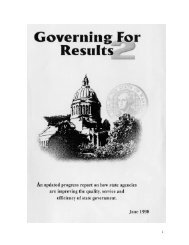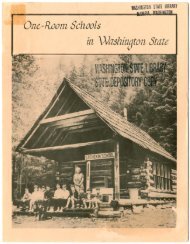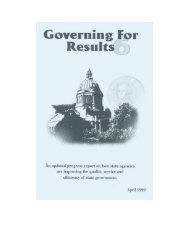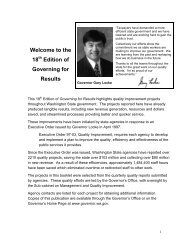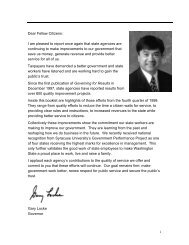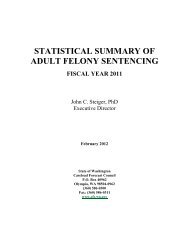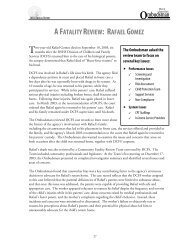BOOTH WHO? - Washington State Digital Archives
BOOTH WHO? - Washington State Digital Archives
BOOTH WHO? - Washington State Digital Archives
Create successful ePaper yourself
Turn your PDF publications into a flip-book with our unique Google optimized e-Paper software.
The Republicans had also lost several seats in the state House and, worst of all, the<br />
U.S. Senate race. Gardner and Adams barnstormed the state on election eve. Gorton was<br />
also hurt way more than helped by a campaign stop in Spokane by President Reagan, who<br />
made a weak statement about the state’s concerns over the prospect of Hanford becoming<br />
America’s nuclear waste dump. While Gardner gained some IOUs in both <strong>Washington</strong>s,<br />
things were too close for comfort in the <strong>State</strong> Senate, where blue dog Democrats, notably<br />
Brad Owen of Shelton and Slim Rasmussen, resisted the leash. “It’s a ‘Slim’ majority,”<br />
quipped Karen Marchioro, leader of the <strong>State</strong> Democratic Party. Booth would need<br />
Republican help to achieve anything big in 1987 and 1988 when he’d be up for re-election.<br />
The governor moved Bill Wilkerson from the Department of Fisheries to the<br />
Department of Revenue because he needed a talented salesman to help him raise taxes to<br />
improve public schools and universities. Appointed fisheries director by Governor Spellman<br />
in 1983, the 40-year-old lawyer helped negotiate a new U.S.-Canada fishing treaty. He<br />
waded into even more troubled waters to try and resolve the tricky resource management<br />
disputes between the tribes and non-Indian commercial fishermen through negotiation<br />
rather than litigation. Joseph Blum, the deputy regional director of the U.S. Fish & Wildlife<br />
Service in Portland, succeeded Wilkerson at fisheries.<br />
* * *<br />
Booth’s sweeping $520 million education-reform package for the 1987-89 biennium<br />
was unveiled just before Thanksgiving. <strong>Washington</strong>’s kindergarten through third-grade<br />
classrooms were among the most crowded in the nation, Booth said, emphasizing that the<br />
early grades were crucial to learning basic skills, forming good study habits and developing<br />
character. He said the state needed to spend $67 million to hire 900 new teachers and<br />
also proposed extending the teachers’ work year by five days to give them more time to<br />
prepare lesson plans and strategize with their colleagues. That move was estimated at $82<br />
million. Some $14 million was proposed for teachers’ “in-service” continuing education,<br />
while about $6 million should be earmarked for drop-out and drug and alcohol-abuse<br />
prevention programs, the governor said. Higher education, meantime, needed an infusion<br />
of $190 million, with most of that earmarked for sorely needed faculty raises of up to<br />
20 percent. The 43,000-member <strong>Washington</strong> Education Association heard a lot to like. It<br />
was wary, however, of merit pay in disguise and “unalterably opposed” to Booth’s plan to<br />
establish a statewide salary schedule. WEA President Terry Bergeson said a uniform pay<br />
scale would make it more difficult for urban districts to compete for quality teachers. Also<br />
criticized as expensive and impractical was Gardner’s proposal to scrap undergraduate<br />
degrees and require every teacher to have a master’s. Gardner countered that the result<br />
would be better trained and better paid teachers. The governor maintained that the WEA<br />
opposed the plan because it tied the infusion of money to higher standards and more days<br />
of professional development.<br />
113




